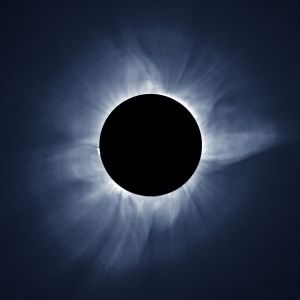
Source: Tristan Savatier / Getty
A total solar eclipse will pass through the US on Monday, Aug, 21 and many have made plans to see it by purchasing official or NASA approved glasses. However many of those glasses have been sold out or not able to be obtained. No glasses? No Worries… Here are some other ways of which you may be able to watch the eclipse safely.
Source WRAL.com
Make a pinhole viewer
The pinhole projector is simple to make. All you need is two pieces of white cardstock, aluminum foil, a thumbtack and tape. With the viewer, you can project a view of the eclipse onto the ground or other surface.
Here’s how to create your own pinhole viewer, courtesy of the Museum of Life and Science.
“You can’t use it to look directly at the eclipse,” Pepple said. But it’s an easy way to take in the event.
If you’re not feeling especially confident in your pinhole viewer crafting and using, the Museum of Life and Science in Durham will host an eclipse event from 9:30 a.m. to 4 p.m., Monday, which includes a chance to make your own pinhole viewer and use it with the guidance of museum staff.
The event and the supplies needed to make the pinhole viewer are free with admission, which is $18 for adults and $13 for kids ages 3 to 12. Eclipse activities are planned all day, but a viewing area will be set up on the concrete plaza of the museum’s butterfly house from 2:30 p.m. to 2:45 p.m.
The museum also will host a free viewing party from 1 p.m. to 4 p.m., Monday, at Blackwell Street Plaza in downtown Durham. Here, visitors will have a chance to make their own pinhole viewers – for free. Families are welcome, but the event is geared more to adults.
You’ll also find pinhole viewer creation stations at N.C. State’s free eclipse viewing party.
Check out some special “scopes”
Also at the Museum of Life and Science, the museum will have two solarscopes, which project a large image of the sun using a series of mirrors and lenses. They are similar to a pinhole viewer, but at a much larger scale.
“This is a great option for viewing the eclipse together as a family, especially if you have been unable to secure a pair of eclipse glasses,” said Karyn Perdue, education program manager for the museum’s The Lab. “Solarscopes actually allow you to see the sun in greater detail. You can often make out sunspots on the surface and since the image is projected onto a screen, your field of view includes the entire sun.”
And, at N.C. State’s event, they’ll have a telescope with a solar filter for safe viewing.
Catch the Live Stream
NASA will be broadcasting a live stream of the solar eclipse on Monday as it passes through the United States. You can watch it at home or join in a community event at places such as the Museum of Life and Science, Marbles Kids Museum in Raleigh, N.C. State and Chapel Hill Public Library.
The N.C. Museum of Natural Sciences in Raleigh will feature a video call from the path of totality in Sylva, N.C., with museum astrophysicist Dr. Rachel Smith. The live video link inside the Daily Planet Theater will give museum visitors the opportunity to see the moon cover 100 percent of the sun. The live stream will run from 2 p.m. to 3 p.m., Monday. It’s free to watch.
An earlier post lists other eclipse events across the Triangle.















